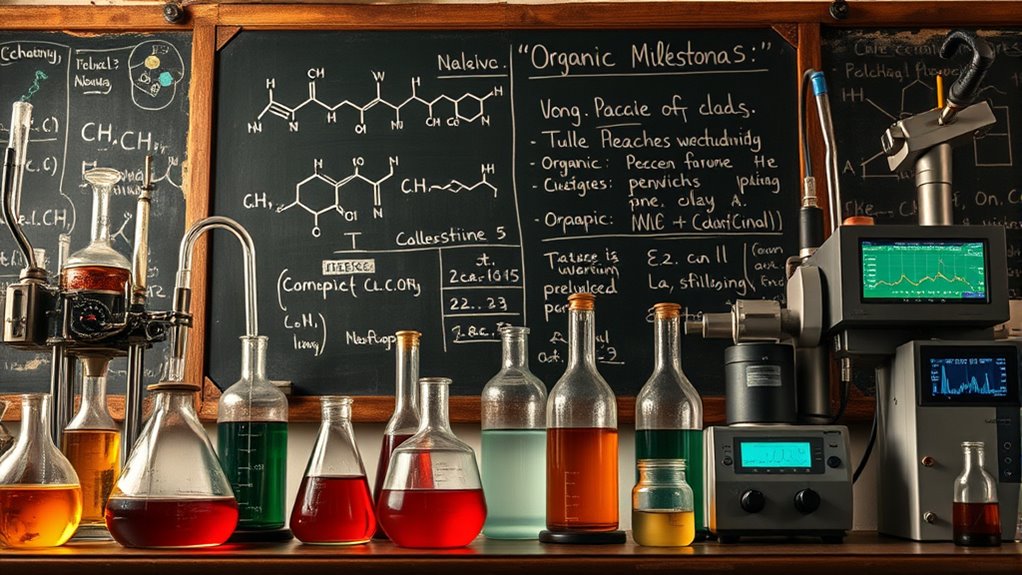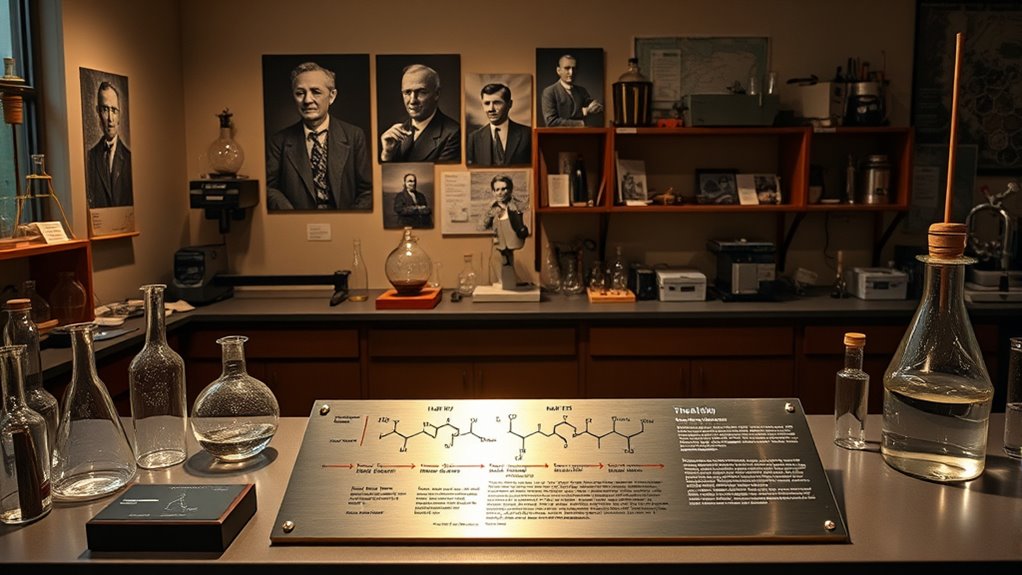Organic chemistry has seen key milestones like Wöhler’s synthesis of urea, proving organic compounds can come from inorganic sources, and Kekulé’s benzene structure discovery. Innovations in reaction mechanisms, stereochemistry, and spectroscopic techniques transformed how you understand molecular structures and bonding. Industrial processes and pharmaceutical developments, like aspirin, also emerged from these breakthroughs. If you explore further, you’ll uncover how these achievements continue to shape modern chemistry and its innovations.
Key Takeaways
- Wöhler’s 1828 synthesis of urea marked the first chemical creation of an organic compound from inorganic materials.
- Kekulé’s 1865 discovery of the benzene ring revolutionized understanding of cyclic molecular structures.
- The development of stereochemistry in 1874 emphasized three-dimensional molecular arrangements.
- The introduction of X-ray crystallography in 1929 confirmed molecular structures like benzene’s bond lengths.
- The synthesis of aspirin by Felix Hoffmann advanced pharmaceutical chemistry in the early 20th century.
Early Foundations and Theoretical Beginnings

Have you ever wondered how organic chemistry began? Early beliefs centered around vitalism, the idea that living organisms possessed a vital force producing organic compounds. Chemists thought these compounds were fundamentally different from inorganic ones, based on their biological origin.
Before the 19th century, this distinction shaped how scientists studied chemicals, with organic substances linked to life processes. However, systematic experiments started questioning vitalism, gradually shifting the view.
In 1806, Jöns Jacob Berzelius coined the term “organic chemistry” for compounds derived from living sources. Pioneering figures like Michel Chevreul and Friedrich Wöhler challenged the vital force theory.
Wöhler’s synthesis of urea from inorganic materials in 1828 marked a turning point, laying the groundwork for a chemical understanding of organic compounds beyond their biological origins. This breakthrough demonstrated that organic compounds could be created through inorganic synthesis techniques, fundamentally changing the field.
Breakthroughs in Synthetic Organic Chemistry

Breakthroughs in synthetic organic chemistry have transformed the way chemists construct complex molecules, enabling precise and efficient pathways to target compounds. The Wittig reaction, discovered in 1954, allows you to synthesize alkenes from carbonyl compounds and phosphonium ylides, revolutionizing carbon-carbon bond formation.
In 1959, hydroboration-oxidation introduced an anti-Markovnikov approach for alcohol synthesis using organoboron reagents, expanding your toolkit for regioselective reactions. The 1979 Nobel Prize recognized innovations by Brown and Wittig in boron and phosphorus reagents, further advancing synthetic methods.
These breakthroughs, combined with the development of retrosynthetic analysis and computer-aided planning, have made complex molecule construction faster and more controlled. Such innovations continue to shape modern organic synthesis, pushing the boundaries of what’s achievable in chemical design and manufacturing.
Industrial Innovations Transforming the Field

The advancements in synthetic organic chemistry laid the groundwork for transforming industrial processes, leading to a surge in innovations that shaped modern manufacturing. You saw the rise of the organic chemistry industry in the late 19th and early 20th centuries, with breakthroughs like William Henry Perkin’s mauveine, revolutionizing dyes, and Felix Hoffmann’s synthesis of aspirin, advancing pharmaceuticals.
The understanding of benzene’s structure by Kekulé and Couper’s work on structural formulas provided essential insights for developing new compounds. Structural formulas became vital, enabling chemists to visualize and predict molecular arrangements more accurately, which facilitated the design of novel chemicals. Catalysis became vital, with processes like Haber-Bosch for ammonia production and homogeneous catalysts improving efficiency. Efficient payment solutions played a crucial role in streamlining the logistics and supply chain operations that supported these large-scale manufacturing efforts. Additionally, industrial automation contributed significantly to increasing production capacity and safety standards in chemical plants. Furthermore, innovations in sustainable practices are increasingly integrated into industrial organic chemistry to address environmental concerns. Advances in green chemistry techniques are now optimizing resource use and reducing waste in chemical manufacturing.
These innovations enabled mass production of chemicals, materials, and dyes, transforming industries and markets. Today, ongoing innovations continue to address sustainability challenges, shaping the future of industrial organic chemistry.
The Development of Analytical and Spectroscopic Techniques

How did scientists uncover the detailed structure of molecules before modern technology transformed analytical methods? They relied on foundational techniques like Bunsen-Kirchhoff spectroscopy in the 1860s, which used flame emission to identify elements such as rubidium and cesium through spectral lines. Early investigations also explored sound vibrations, laying the groundwork for future spectroscopic advancements. Colorimetric methods, like Nessler’s ammonia analysis from 1856, allowed quantification based on color changes. Spectroscopy validated atomic emission patterns, linking spectral signatures to elemental identity. The legacy of Newtonian prism experiments laid the groundwork for spectral analysis. Early absorption studies hinted at molecular vibrations, foreshadowing IR spectroscopy’s development. These innovations provided essential insights, enabling chemists to analyze and understand molecular structures long before the advent of modern instruments like mass spectrometry, NMR, and X-ray diffraction, as researchers continued to refine spectroscopic techniques. Additionally, the development of regional analytical resources and the sharing of techniques among scientists further accelerated advances in molecular analysis. The exploration of spectroscopic principles also contributed significantly to the understanding of atomic and molecular behavior, guiding future technological breakthroughs. Moreover, the integration of early optical devices played a crucial role in enhancing the resolution and sensitivity of initial spectroscopic experiments.
Advances in Understanding Chemical Bonding and Structure

Understanding the nature of chemical bonds has profoundly advanced our knowledge of molecular structures, shaping how you visualize and manipulate organic compounds.
In 1865, Kekulé’s discovery of the benzene ring revolutionized the understanding of cyclic structures. By 1874, van ’t Hoff and Le Bel introduced stereochemistry, revealing the importance of three-dimensional arrangements.
In 1929, Kathleen Lonsdale used X-ray crystallography to confirm benzene’s equal bond lengths, solidifying models of bonding. This technique marked a significant breakthrough in molecular structure analysis.
Gilbert Lewis’s 1916 covalent bond theory explained how atoms share electrons, while Linus Pauling’s resonance concept in the 1930s clarified molecular stability. The advent of computational chemistry has further advanced the visualization and prediction of complex molecular structures.
Quantum mechanics further validated these models, supporting the understanding of bonds and structures. Additionally, the development of spectroscopic techniques has enabled chemists to analyze molecular structures with greater precision, greatly enhancing our understanding of chemical bonding. The integration of these techniques has created a more comprehensive framework for studying molecular interactions.
Furthermore, advances in crystallography technology have provided detailed insights into the three-dimensional arrangements of atoms within molecules, complementing spectroscopic data and enriching our grasp of molecular geometry. These milestones collectively transformed your comprehension of molecular architecture, critical for advancing organic chemistry.
Mechanistic Insights and Reaction Pathways

Since the mid-20th century, developing insights into reaction mechanisms has transformed organic chemistry from a descriptive science into a predictive discipline. You now understand how molecules behave through detailed pathways. Dad – Amazing Life Together has often highlighted how guidance and support can lead to remarkable achievements, much like how mechanistic insights have advanced the field. Key milestones include:
- The foundation laid by Sir Christopher Ingold, who clarified substitution reactions and introduced the concept of electron movement.
- The development of mechanistic theories, like electronic valency models and the use of curly arrows, which visualize electron flow. Reaction mechanisms now serve as essential tools for predicting chemical behavior.
- Advances in nucleophilic substitution, distinguishing SN1 and SN2 mechanisms, enabling better reaction prediction and control. The integration of computational methods has further refined mechanistic understanding, allowing chemists to simulate and analyze complex reactions with greater accuracy.
These insights allow you to predict reaction outcomes confidently. Combining experimental and computational methods further refines your understanding, leading to more efficient synthesis and catalyst design.
Milestones in Methodology and Synthetic Planning

The development of systematic methodologies and strategic planning techniques has revolutionized organic synthesis over the past century. You now rely on structural formula development, starting with Kekulé’s 1865 line-bond models, including benzene’s cyclic structure. Stereoisomer classification improved with Prelog’s 1954 rules, enabling precise stereochemical control. Spectroscopic methods like infrared and UV in the 1950s became essential for structural analysis, while Corey’s early computational tools in 1957 advanced synthesis planning. Retrosynthetic analysis, formalized by Corey in 1957, transformed complex molecule design, with bond disconnection strategies evolving through the 1960s and the synthon concept in the 1970s. Milestones in stereochemistry, organometallic reactions, and green chemistry further refined your ability to plan efficient, selective, and sustainable syntheses. Advances in regulatory frameworks] continue to shape the development of safer and more environmentally friendly synthetic methods.
Frequently Asked Questions
How Did Organic Chemistry Influence the Development of Pharmaceuticals?
Organic chemistry considerably influences pharmaceutical development by enabling you to synthesize complex molecules with precise structures.
You can design and create drugs with targeted pharmacological effects, using advanced techniques like asymmetric synthesis and novel reactions. This field helps you scale up production efficiently, ensuring drugs are available for widespread use.
What Role Did Organic Chemistry Play in Environmental Science?
You see, organic chemistry plays a crucial role in environmental science by helping you understand pollutant behaviors and develop detection methods like GC-MS.
It guides you in creating pollution control technologies such as catalytic converters and bioremediation strategies. Organic reactions also enable sustainable energy solutions like biofuels and organic solar cells.
How Have Computational Methods Advanced Organic Chemistry Research?
You immerse yourself in the world of molecules dancing on your screen, where computational methods sharpen your understanding. These tools let you visualize complex reactions and predict structures with precision. They act as your digital microscope, revealing hidden interactions and conformations.
What Are the Future Trends in Organic Synthetic Methodologies?
You’ll see future trends focusing on sustainable and efficient methods. Expect increased use of enzyme catalysis, photocatalysis, and mechanochemistry to reduce environmental impact.
AI-driven tools will optimize synthesis routes and automate processes, making research faster and more reliable.
Continuous flow chemistry and biocatalysis will become standard, aligning with circular economy principles.
Together, these innovations will revolutionize organic synthesis, making it greener, smarter, and more accessible.
How Has Organic Chemistry Impacted Material Science and Nanotechnology?
You see, organic chemistry has revolutionized material science and nanotechnology like nothing else. It enables you to manipulate matter at the tiniest scales, creating groundbreaking nanomaterials, graphene, and hybrid structures.
You can design functional materials with incredible precision, impacting everything from semiconductors to biocompatible devices. This field’s innovations unleash endless possibilities, pushing the boundaries of what’s possible at the nanoscale and transforming our future in extraordinary ways.
Conclusion
As you journey through the milestones of organic chemistry, think of it as a winding river carving its path through time. Each discovery is a ripple, shaping the flow toward greater understanding and innovation. The currents of theory, technique, and application carry you forward, transforming raw elements into complex life. Embrace this ongoing voyage, for every breakthrough is a new tributary feeding the vast ocean of knowledge waiting to be explored.









